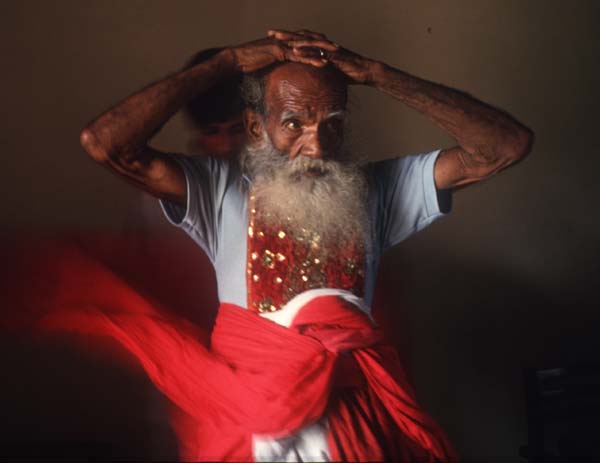
|
|||||||||||||
|
| |||||||||||||
Rites and rituals of the Sri Dalada Perahera
There are special religious programs conducted in the Maligawa on every Full Moon Poya day where large numbers participate. Apart from these daily, weekly and monthly ceremonies, there are four major ceremonies held every year. They are:
Of these the most important is the Asala Mangalaya. Asala, according to the Sinhalese Calendar, is the month of July/ August This is the months in which Kandy gets into a festive mood. Shop-keepers and hoteliers pile up their stock to cater to the massive crowds that throng the city. Maligawa and its premises are gaily decorated and are illuminated with strings of lights, including the esplanade. These lights burn throughout the night. A few days before the Perahera, A Kapa, a sapling from a tree that sheds milky juice is erected in each of the four Devales. On the 5th day, The Kumbal Perahera begins and goes on for 10 consecutive nights when the sacred relic casket is taken round the streets of Kandy accompanied by exotically costumed dancers and drummers. These dance forms vary. The most popular dance froms are the Ves, Udekki, Pantheru, Naiyandi, Hewisi, Savang and Leekeli and the dancers with years of experience reveal their dexterity in the performance of their respective dances. The most colorful Perahera is last Randoli Perahera which falls on the Asala Full Moon Poya day. On this day, at the auspicious time the Perahera starts. The Diyawadana Nilame in full traditional Kandyan dress will enter the inner chamber to receive the Perahera Karanduwa containing the Buddha Relics. The Mahanayake Thero will place the relics casket on the velvet cloth clonintricately embroidered with gold and silver, held by both hands by the Nilame. As he steps out of the chamber bearing the relics casket, the crowd with one heart and one voice starts chanting sadhu, sadhu, sadhu and the chorus will go on while the mini perahera begins. A red and yellow floor spread (pavada) embroidered with appliqués of different hues is laid before him, and two Temple functionaries will start strewing jasmine flowers on it while the Diyawadana Nilame, carrying the casket, will slowly tread over the pavada. In front of him two hand torches are held by bearers while the kavikaramaduwa sing songs in praise of the Dalada. The Nilame walks past the udamale and begin to descend the wooden staircase and go past the digge and ambarawa and finally arrives the place where the tusker is waiting to carry the casket.
The casket containing the Buddha Relics is always carried by a tusker decorated with a is magnificent dress embedded with colored bulbs and generally looks more colorful then the other caparisoned elephants numbering over 75 who take part in the Perahera. The decorated ransivige is placed on the back of this tusker and the relics casket is placed inside it on, a velvet cushion, by the Nilame. After the Nilame and the Mahanayake Thero strew jasmine flowers on the casket the tusker arrives at the wahalkada followed by the Nilame. The Perahera proper begins as the canon booms. Leading the n Perahera is the band of whip crackers who crack their whips in rhythmic pattern announcing it that the Perahera is on. Immediately following are two o flag bearers carrying the two flags of the Sathara Korale (known as Ira Kodiya) embossed with the symbols of the sun and the moon indicating the wish that this Perahera be held until the sun and the moon last. Next comes the peramunerala, attired in the traditional white dress and riding a caparisoned elephant and carrying the sannasa, the royal charter to hold the Perahera. Following him is the Gajanayake, A the Maligawa official in charge of the elephants, elegantly dressed in traditional Kandyan dress carrying the ankusaya the instrument by which elephants are controlled. The crowd is impatiently waiting to get a glimpse of the tusker carrying the relics casket. It's a wonderful sight to see the tusker r dressed in a decorated costume and brilliantly illuminated bearing the ransivige in which the Perahera Karandawa rests on n velvet cushion, with garlands of jasmine flowers hanging dangling above it and strings of lights flickering all the time, tread over the pavada in easured steps under the canopy held over the ransivie by 16 able bodied men with poles and strings. As the karanduwa passes by, the crowd, stand up and with their hands clasped together chanting sadhu, sadhu, sadhu thereby paying their homage to the Sacred Tooth Relic. The focus of the crowd then moves towards the Diyawadana Nilarne who, attired in his traditional Kandyan constume, slowly walks by under a large e embroidered umbrella held by a Vidane of the Maligawa and e flanked by two troupes of Ves dancers whose performance is a lovely sight to see. Over 75 caparisoned elephants, thousands of dancers and drummers, hundreds of flag bearers and torchbearers take part in each of the Peraheras. The Maligawa Perahera is followed by the Devala Peraheras in the order of Natha, Vishnu, Kataragama and Pattini under the direction of the respective Basnayake Nilames, who in their traditional Kandy an costumes, take part in the Perahera. After the day perahera, it is e customary for the Diyawadana Nilarne and the Basnayake Nilames of the four devalas to report to Her Excellency the' President that the Perahera was satisfactorily Conducted. As the Perahera draws to an end, the onlooker is apt to conclude that it is nothing but sheer ingenuity of the Bliddhists from ancient times to have organized the country's talents in arts and g crafts including drumming and dancing into a cultural pageant of such magnitude and offer it to the Sacred Tooth Relic of Lord Buddha as a form of veneration. Extracted from an article by Neranjan Wijeyeratne (Diyawadana Nilame) More articles about the Kandy Perahera
| |||||||||||||

